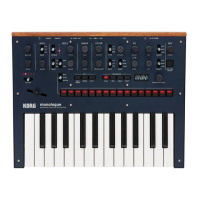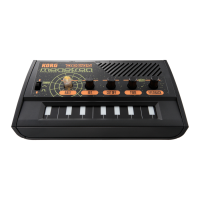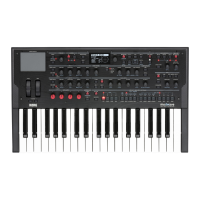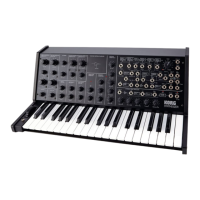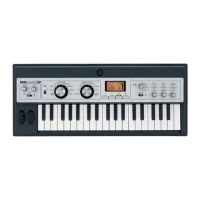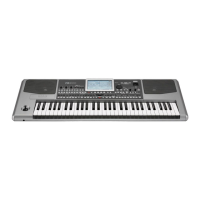Mbr bus end. since there are foww
Slaw
osriilatrjft
(which produce em*
phaiind harmonics) than in Single
mode
Q.FREQ moo (-- intensity** end
•fcouroe")
Meets
the
type and amount erf fre-
ejuariCY
modulation applied
to
the
SfcweVCOsonly.
1
INTENSITY
Determines
the
depth of
frequency
modulation apptied
to the
Slave
otel'*
lators.
2.
SOURCE
a.
VCF
EG
- The
Voltage
Controlled
Filter Envelope Generator is used
to weep the Slave oscillators every
time a new trigger is generated (The
VCF may be swept simultaneously
r
if desired).
b> MG-1
-
The
output
of Modulation
Generator l
.%
mod
to
continuously
sweep the Slavs oscillators, produc-
i'hj
a
constantly
changing timbre
regardless of whether or not now
key* are played The different
MG-T waveforms may be used
to
create various kind* of sweep*
D. X-MOD Intensity
Determines the amount of Cross
Modulation m X-MOD or
S & X
modes- it has no effect
in
SYNC
mode.
To
understand
the uses of this section,
you
should
understand the basic opera-
tion of
cast of (runs effects*
SYNC (Synchronized
Swept Oscillators!
— In
Sync
mode,
two (or more) oscilla-
tors are first electronically
"locked" to-
gether {i.e., synchronized)
such that one
or nore "Slave" oscillators
are forced to
remain in perfect tune with each
"Mas*
ear"
oscillator.
BY
itseHf (i.e., with no
modulation). Sync is useful for eliminat-
ing the "beating" effect between closely
tuned oscillators, (This can
be
obtained
by engaging SYNC with th© Effects sec-
tion
FflEQMOD
control
at
'XI",)
If, however, you attempt
to
"sweep"
(La,, modulate
over
a wide range) the
Slave
oscillators us*ng an envelope genera-
tor,
modulation
generator, or pitch
wheat,
a very
different
effect is created.
Since the
sync circuit prevents the pitch
of
Ihe Slave
oscillators
from changing, the
waveform
is altered instead, in effect
being "forced" through the harmonic
series of
the Master oscillator. The result
h a complex, constantly changing wave
form which produces
a
very rich and
exciting sound reminiscent of an over
rjriven
lead guitar.
The FREO MOO controls and the Enve-
lope Generator or Modulation Generator
1 control settings all affect the sound
produced. The number of Master and
Slave oscillators 1SINGLE
DOUBLE)
and
the
oscillators
initial tuning (which con be
preset
using
the
CHORD MEMORY fea-
ture)
are also factors tn the resulting
timbre.
X-MOD {Crou
Modulation)
-
refers to
one lor morel oscillators
being
frequency
modulated
by
another
oscillator,
resulting
in
a
series of complex
non-harmonic
"sum
and
difference"
frequencies (ceiled
srie bands). This creates
a
metallic "bail/
gong"-Jike sound, very similar
to that of a
Ring Modulator. The
X-MOD Intensity
control has
a
pronounced effect
upon the
overall
sound, as does the VCO waveform
settings, particularly PWM* Detuning the
oec-LLotors using the
CHORD
MEMORV
feature
will further alter the sound.
Ad
di|tonally, sweeping the modulated
rsfavn") oscillators with an envelope
generator, modulation generator or
pitch
wheel will create
a
highly jnu&ual "con-
trary motion" effect, with different
pitches gliding in different directions.
SY rvC/X-MOD -
The
result of combining
both SYNC and X-MOD effects together
produces yet another group of sounds,
thereby further increasing the flexibility
of your Monopoly.
As
wtth
X-MOD,
one
osdllator modulates others
so as to
pro
duce sum and difference frequencies
(side
bands). Howftwr. since the oscillators
are
also syrchromred and swept
as
in SYNC
mode, these sidebands all become harmo-
nically
related The result of this is an
intensified
sweep of harmonics that con
onty be
characterized
as
"shimmering"
and extremely powerful
The
X-MOD Intensity has a pronounced
effect
upon
the tunal quality
of
the
combined effect-
At
"0",
the normal
SYNC
sweep
ts produced; advancing the
control doefcwise introduces gradual
changes in the sound Quality
and
greater
timbre complexity.
21
